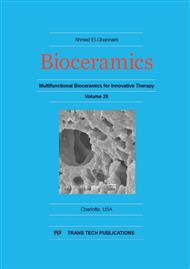p.21
p.25
p.31
p.37
p.41
p.46
p.53
p.58
p.65
Spectroscopic Studies of Adsorbed Myoglobin on Zinc Containing Hydroxyapatite
Abstract:
The knowledge on human tissue is very important to recognize desirable properties of biomaterials. Host cells, extracellular matrix, integrated vessels and interstitial fluids create a complex and dynamic system able to regenerate and respond to environmental stimuli. Myoglobin is a protein with most of α-helices on its secondary structure, and responsible for oxygen binding and release in muscles, by the heme group. This work investigates the Mb adsorption process onto zinc-hydroxyapatite (ZnHA) surface by spectroscopic studies. To do so, ZnHA (0.05 g) was incubated with 4mL of 2mg Mb/mL on phosphate buffer solution pH 6.0 for 24h at 37°C. The FTIR analyses of ZnHA powders before and after protein adsorption provided information concerning the protein content. UV-Vis spectrocopy in the reflectance mode suggested a mixture of MbO2 and Met Mb on lyophilized solid Mb, and the prevalence of MetMb form when Mb was adsorbed on ZnHA sample. The decrease of UV-Vis secondary bands suggests interactions through the Mb heme group and the ZnHA surfaces. Circular Dichroism (CD) spectroscopy indicated the maintenance of the Mb α-helices secondary structure after the adsorption process on ZnHA powders.
Info:
Periodical:
Pages:
41-45
Citation:
Online since:
November 2016
Keywords:
Price:
Сopyright:
© 2017 Trans Tech Publications Ltd. All Rights Reserved
Share:
Citation:


